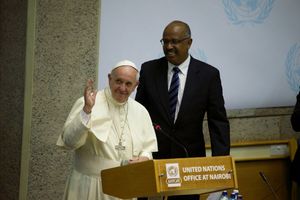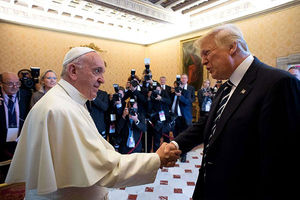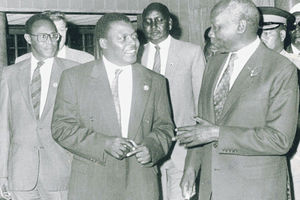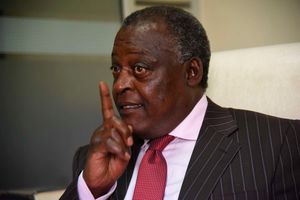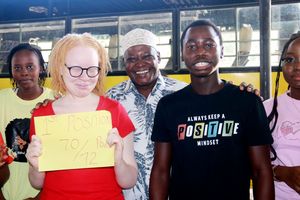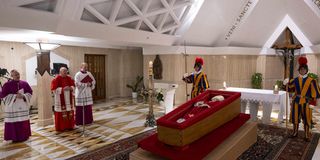
Pope Francis's body lies in state at the chapel of Santa Martha at Vatican City.
A dying Pope Francis waved his hand at his personal healthcare assistant before slipping into an irreversible coma, the Vatican’s press arm has reported.
According to Vatican News, run by the Vatican Dicastery for Communication, the assistant—Mr Massimiliano Strappetti—had been working with the Pope for years.
Mr Strappetti, a nurse, was there on Monday morning when the Pope’s health deteriorated. Vatican News said this happened at 5.30 am Italian time.
“Around an hour later, after making a gesture of farewell with his hand to Mr Strappetti, lying in bed in his second-floor apartment … the Pope fell into a coma,” the media outlet reported.
“According to those who were with him in his final moments, he did not suffer. It all happened quickly. His was a discreet death, almost sudden, without long suffering or public alarm,” it added.
The time of death, as announced on Monday, was 7.35 am Italian time.
The revelation of the pontiff’s last moments came as insiders and the media sought to fill the gaps and come to terms with his sudden departure after he had been seen in public the previous day.
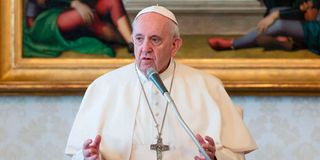
Pope Francis during a past function.
Some of the topics that various media houses have been examining include: Why did he never visit his home country of Argentina as Pope? Did he defy his doctors’ advice and meet faithful on Easter Sunday after nearly 40 days in hospital? Why did he not resign like his predecessor when he realised his health was failing him? What had he said previously on living and dying?
Pope Francis’s death, according to a government official at the Vatican, was due to a “stroke, followed by a coma and irreversible cardiocirculatory collapse” as reported by Vatican News.
Irreversible cardiocirculatory collapse refers to a sudden failure of the system that pumps blood around the body.
“According to the medical report, the Pope had a prior history of acute respiratory failure caused by multimicrobial bilateral pneumonia, multiple bronchiectases, high blood pressure and Type II diabetes. His death was confirmed through electrocardiographic thanatography [usage of specialised devices to check the electric signals coming from the heart],” said Vatican News, quoting Dr Andrea Arcangeli, the director of the Directorate of Health and Hygiene of the Vatican City State.
Before he joined Christians on Easter Sunday, Pope Francis at one point asked Mr Strappetti, “Do you think I can manage it?”
"He was hesitant"
The question, Vatican News reported, was posed by a hesitant Pope Francis ahead of meeting 50,000 faithful at the St Peter’s Basilica aboard the popemobile.
“Tired but content, the Pope afterwards thanked his personal healthcare assistant, saying, ‘Thank you for bringing me back to the Square,’” Vatican News reported. “The Pope then rested on Sunday afternoon and had a quiet dinner. Around 5.30 am, the first signs of the sudden illness appeared, prompting an immediate response from those keeping watch over him.”
This is even as the BBC reported that the Pope may have defied doctors’ advice to attend the Easter Sunday prayers. It noted that he had been told by his doctors “to spend two months convalescing after 38 days in hospital with double pneumonia”.

Pope Francis celebrates Mass at the University of Nairobi on November 26, 2015. He was the third pope to visit the continent.
“Doctors who treated Francis at Rome’s Gemelli hospital had prescribed a regimen of complete rest—but it was never likely that a typically active Pope who spent much of his papacy meeting people would keep to that,” added the BBC. “Francis had already made it clear he wanted to be back in the Vatican in time for Easter, as soon as the specialists treating him explained that his health issues would not be resolved quickly.”
Pope Francis had spent the Thursday before Good Friday meeting prisoners at the Regina Coeli jail in Rome, where he arrived in a wheelchair. He, however, did not wash their feet as he usually did.
“This year I’m unable to do that, but I can and want to still be near you,” the BBC quoted him saying, adding that it was in a “feeble voice”.
The Vatican released a document that Pope Francis had written in June 2022 that will guide how he will be buried.
“As I sense that the twilight of my earthly life is approaching, and with firm hope in eternal life, I wish to express my final wishes regarding my burial place,” he wrote.
He asked that his tomb should be on the ground, departing from tradition where popes are buried in crypts that are more or less like drawers inside a large cabinet.
Vatican News also shared another piece of writing by Pope Francis on February 7 as he penned a preface to a book by Cardinal Angelo Scola titled “Awaiting a New Beginning: Reflections on Old Age”.
“We must not be afraid of old age, we must not fear embracing becoming old, because life is life, and sugar-coating reality means betraying the truth of things,” Pope Francis wrote.
“Death is not the end of everything, but the beginning of something. It is a new beginning ... because eternal life, which those who love already begin to experience on earth within the daily tasks of life,is beginning, something that will never end,” he added. “And it is precisely for this reason that it is a ‘new’ beginning, because we will live something we have never fully lived before: eternity.”
Argentina home
A spot check on Amazon showed that Pope Francis’ autobiography released earlier this year, titled “Hope”, was topping the sales charts in the “Christian church leadership” category.
Elsewhere, the BBC reported on Pope Francis never travelling to his home country, Argentina, as pontiff.
“During his papacy, Francis visited four of the five countries that border Argentina—but never his home country, despite continuing to take a keen interest in it,” said the BBC, which added that Argentina has declared seven days of national mourning. Italy, in whose borders Vatican City is located, has declared five days of mourning.
“The initial pride felt by most Argentines after the announcement that a fellow countryman would be the first Latin American pope gave way to disenchantment among some over the years. A Pew Research Centre survey suggested that the proportion of people who held a positive view of the pontiff fell from 91 per cent in 2013 to 64 per cent in 2024,” wrote the BBC.
The Associated Press delved into why Pope Francis never resigned like his predecessor, Pope Benedict XVI.
“While Francis kept open the possibility, and even had a resignation letter prepared, he said more recently that he believed that the papacy was for life,” the agency noted. “While confirming he had a resignation letter prepared in case he became medically incapacitated, he pointed to the risks that papal resignations might become a ‘fashion’ or the norm.”
Meanwhile, African leaders of the Roman Catholic Church, who witnessed at least 10 visits by Pope Francis during his tenure, mourned the Pope as an understanding leader of the church.
The Catholic Information Service for Africa quoted Cardinal Fridolin Ambongo, a confidant of Pope Francis and also the Archbishop of Kinshasa, saying the pontiff’s death was a blow to Africa.
“Pope Francis was a shepherd who walked with us, listened to our struggles, and gave voice to our hopes. His death is a great loss to the universal Church and especially to Africa, which he loved dearly,” said Cardinal Ambongo.
In Kenya, Capuchin TV aired the reactions of Nairobi Archbishop Philip Anyolo, who focused on Pope Francis’ conceptualisation of 2025 as the year of jubilee (forgiveness and reconciliation).

A handout picture taken on October 26, 2013 and released by Osservatore Romano on October 29, 2013 shows Pope Francis addressing the crowd at St Peter's square in the Vatican with a boy standing next to him on the occasion of Family Day.
“Even before his demise, he was very much emphasising on the jubilee year of hope; looking at the world, how things are going, having war everywhere, even in bigger countries and big economies, war that affects even the small ones,” he said.
In a statement issued yesterday, Archbishop Anyolo announced that a requiem mass for Pope Francis will be held at the Holy Family Minor Basilica on Friday from 11am.
The National Council of Churches of Kenya (NCCK), an umbrella body for protestant denominations in the country, also mourned Pope Francis. In a statement, NCCK’s national chairman, Dr Elias Otieno Agola, said they stood with the Kenya Conference of Catholic Bishops in mourning a life “so fully lived in the service of God and humanity”.
“Pope Francis was not only a shepherd of the Roman Catholic Church but a spiritual father and moral compass to millions across faiths,” Rev Agola noted.
From the Vatican, traditions following the death of a Pope kept unfolding. One of them was the locking of the doors of the Pope’s personal residence using a ceremonial tape.
“The palace will remain sealed until the start of the conclave, when cardinals will gather to elect a new Pope,” reported Al Jazeera.
A programme released by the Vatican indicated that the funeral mass for Pope Francis will be held at St Peter’s Basilica on Saturday at 11am Kenyan time.

